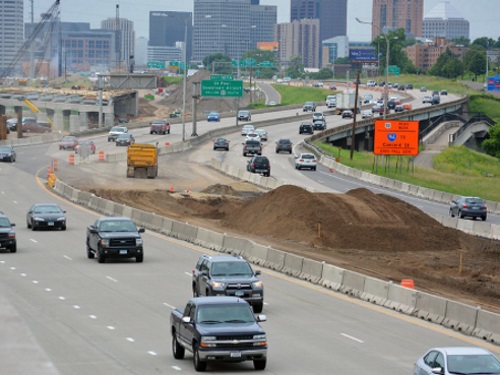The Ray and consulting firm NGI recently released the NextGen Highways Feasibility Study for the Minnesota Department of Transportation that examined strategies for “co-locating” electric and communications infrastructure in highway right-of-ways or ROWs.
[Above photo by the Minnesota DOT]
The study focused on the potential deployment of buried, high-voltage/direct current or HVDC transmission lines within Minnesota interstate and highway ROWs – an effort that offers broader implications for highway ROW strategies in other states.

In April 2021, the Federal Highway Administration released guidance clarifying the highway ROW “can be leveraged by state DOTs for pressing public needs relating to climate change, equitable communications access, and energy reliability.”
Projects listed include renewable energy generation, electrical transmission and distribution projects, broadband projects, vegetation management, inductive charging in travel lanes, and alternative fueling facilities, among others.
The Ray – a corporate venture devoted to roadway technology testing – said its NextGen Highways research team worked with an internal working group at the Minnesota DOT to “explore opportunities and barriers” associated with locating buried HVDC transmission within the highway ROW.
Specifically, its NextGen Highways team and working group reviewed applicable policy and projects, analyzed Minnesota DOT-specific concerns, examined HVDC transmission line requirements, and assessed buried HVDC cost and benefits.

“Federal policy not only authorizes building electrical transmission and fiber along our roads, but it also strongly encourages State DOTs to approach infrastructure planning with a wide lens, taking into account both immediate and future public needs that could be met by leveraging transportation ROW,” said Laura Rogers, deputy director of The Ray, in a statement.
“To support clean vehicle electrification, our existing transportation infrastructure will need to evolve to incorporate the infrastructure to power and connect these vehicles,” she added. “This feasibility study demonstrates that states can use existing publicly-owned land to help solve our Nation’s greatest and immediate challenges in the energy, transportation and communications sectors.”
[Editor’s note: A session held during the 2021 annual meeting of the American Association of State Highway and Transportation Officials explored ways to make right-of-ways or ROWs maintained by state departments of transportation a source of opportunity instead of just an operational expense.]
“The findings from this study demonstrate that buried HVDC transmission is cost-effective and can be feasibly sited in interstate and highway ROW after making appropriate consideration for existing and future transportation system needs,” noted Morgan Putnam, founder of NGI Consulting.
“This means that our existing highway system can enable transportation and grid de-carbonization and strengthen grid reliability and resilience – all while delivering billions of dollars in societal benefits,” Putnam said.
The Feasibility Study also found that Wisconsin provides a “good playbook” for siting and building transmission in highway ROW.
“Utilities and regulators in Wisconsin have successfully collaborated with the Wisconsin Department of Transportation to place more than 800 miles of electric transmission infrastructure within and along state and interstate highway ROW over the last 20 years,” explained Randy Satterfield of Satterfield Consulting, which also participated in the study. “Other states across the country now have the opportunity to do the same.”
 Nation
Nation
Registration Open for AASHTO’s Winter Rail Meeting
December 19, 2025 Nation
Nation

